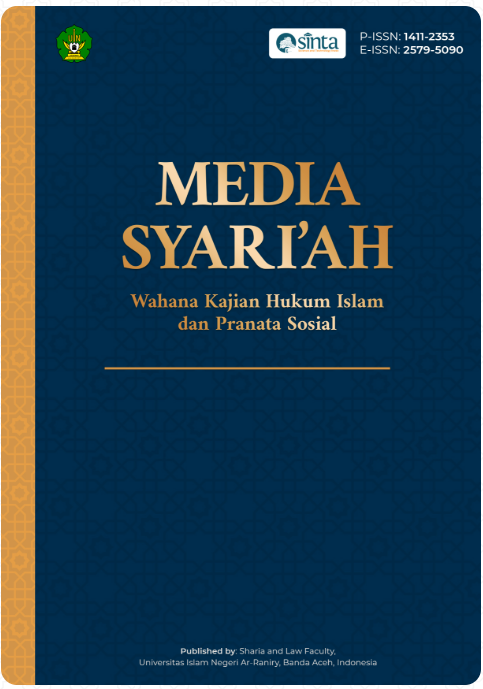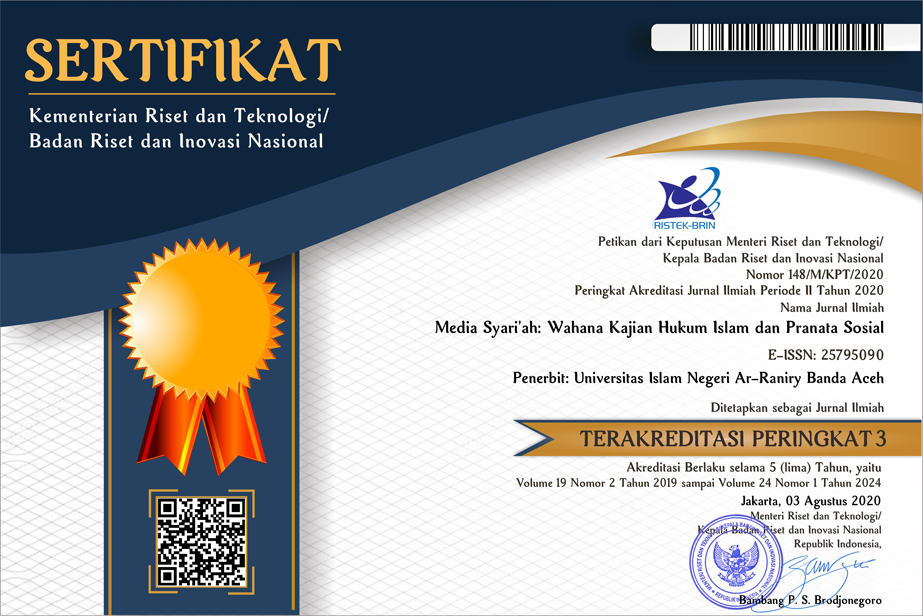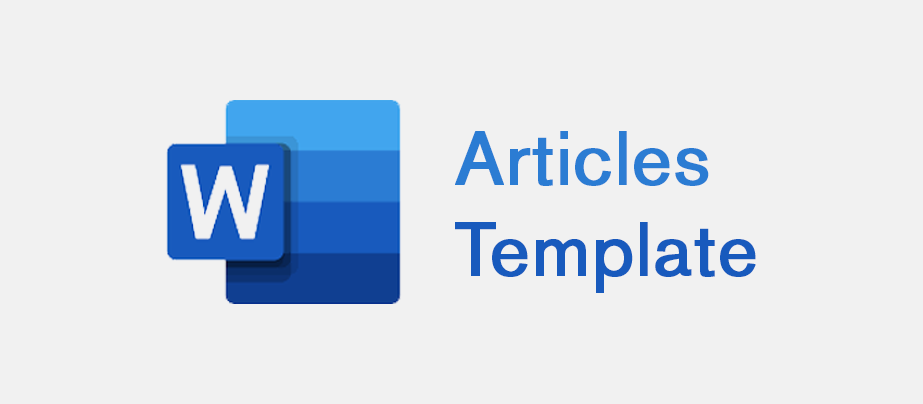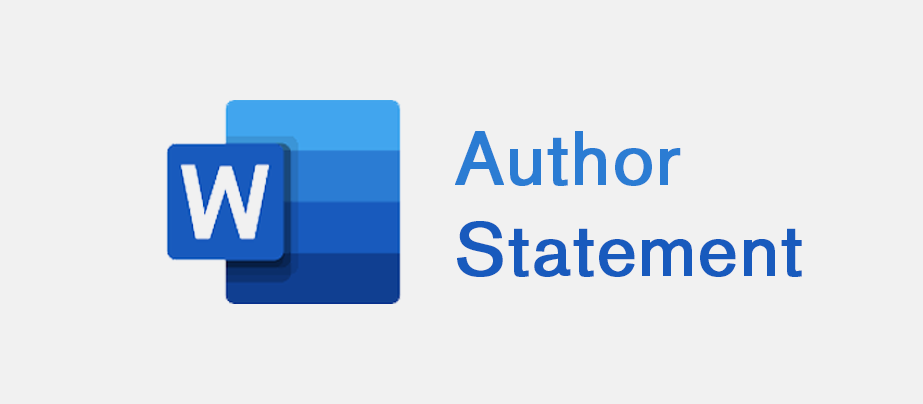Contestation Between Islamic Law and Patrilineal Traditions: Insights from the Toba Batak Community
DOI:
https://doi.org/10.22373/jms.v26i2.28789Keywords:
toba batak muslims, customary traditions, islamic law, adaptation, negotiation, harmonyAbstract
The purpose of this study is to examine how the Toba Batak Muslim community maintains its cultural identity in the face of complex dynamics while adapting to Islamic principles in the face of urbanization and economic change by examining the pattern of relationships between Islamic law and customary traditions. Three regions—traditional rural areas (Humbang Hasundutan, Tapanuli Utara, Samosir, Toba), multireligious communities (Asahan, Tanjung Balai, Labuhanbatu), and large cities (Medan, Bandung)—are the focus of this qualitative study using a case study methodology. The study's findings highlight three key trends in the interaction between Islam and customs: harmony, compromise, and adaptation. The adaptation trend is evident in individuals from the place of origin who endeavor to maintain practices with minimal impact from Islamic law. A negotiation pattern has developed among individuals in diverse religious contexts who want to reconcile local customs with Islamic principles. Simultaneously, a pattern of harmony is observed in metropolitan areas, where individuals successfully reconcile traditions with Islamic tenets within a contemporary framework. Economic conditions and social mobility significantly influence these trends. Individuals with superior economic advantages often prioritize religious ideals, whereas others with economic constraints rely more on customs as a social mechanism. Social mobility facilitates the adaptation of traditional values to be more flexible and inclusive of Islamic beliefs, particularly in metropolitan settings. This study suggests that economic factors and social mobility act as catalysts in transforming the link between customs and religion within the Toba Batak Muslim community. Research recommendations emphasize the significance of locally-based religious education, inclusive discussion between indigenous and religious leaders, and economic empowerment to foster harmony between traditional beliefs and Islam.References
Arimbawa, W., & Santhyasa, I. K. G. (2010). Perpektif Ruang Sebagai Entitas Budaya Lokal Orientasi Simbolik Ruang Masyarakat Tradisional Desa Adat Penglipuran, Bangli-Bali. Local Wisdom: Jurnal Ilmiah Kajian Kearifan Lokal, 2(4), 1–9.
Bovill, K. J. (1986). Toba Batak and Alliance: Family Descisions in an Urban Context. 2, 388.
Butarbutar, E. N. (2019). Perlindungan Hukum terhadap Prinsip Dalihan Natolu sebagai Hak Konstitusional Masyarakat Adat Batak Toba. Jurnal Konstitusi, 16(3), 488. https://doi.org/10.31078/jk1633
Cunningham, C. E. (1958). The postwar migration of the Toba-Bataks to East Sumatra. Cultural report series.
Davie, G., Ammerman, N. T., Huq, S., Leustean, L. N., Masoud, T., Moon, S., Olupona, J. K., Sinha, V., Smilde, D. A., Woodhead, L., Yang, F., & Zurlo, G. (2018). Religions and Social Progress: Critical Assessments and Creative Partnerships. Rethinking Society for the 21, 3, 641–676. https://doi.org/10.1017/9781108399661.003
Elizabeth, R. (2007). Socio-Metamorphosis Phenomenon of Farmers: Towards the Favor of Disadvantage Farmer’s Community in Rural Areas Related to People’s Economy Concep. Forum Penelitian Agro Ekonomi, 25(1), 29–42.
Firmando, H. B., Simbolon, E. T., & Lumbantobing, R. (2023). Relasi Agama, Kebudayaan dan Politik pada Masyarakat Batak Toba di Kabupaten Samosir. Jurnal Sosiologi Agama Indonesia (JSAI), 4(3), 293–312. https://doi.org/10.22373/jsai.v4i3.2939
Fitriyani, L. R., & Nurhajati, L. (2018). Pola Komunikasi Kekerabatan Suku Batak Dalam Penggunaan Marga Untuk Menjalin Keakraban. WACANA, Jurnal Ilmiah Ilmu Komunikasi, 17(2), 163. https://doi.org/10.32509/wacana.v17i2.620
Fredriko, A. (2024). Konstruksi Sosial Realitas Perempuan Batak Toba sebagai Parhobas pada Komunitas Adat Batak Toba di Kota Salatiga. Jurnal Neo Societal, 6(2), 141–152.
Hourani, G. F. (Ed.). (1985). Islamic theology and Muslim philosophy. In Reason and Tradition in Islamic Ethics (pp. 6–14). Cambridge University Press. https://doi.org/DOI: 10.1017/CBO9780511570780.006
Kasim, F. M., & Nurdin, A. (2020). Study of sociological law on conflict resolution through Adat in Aceh community according to Islamic law. Samarah, 4(2), 375–397. https://doi.org/10.22373/sjhk.v4i2.8231
Krämer, G., & Schmidtke, S. (2014). Speaking for Islam: Religious Authorities in Muslim Societies. Brill. https://doi.org/https://doi.org/10.1163/ej.9789004149496.i-310
Kumara, Anis Rizki; BW, Muh. Kurniawan; Pradana, A. F. K. (2024). ANALISIS HUKUM ISLAM DAN HUKUM ADAT DALAM PEMBAGIAN WARISAN DI KELURAHAN JETIS KABUPATEN SUKOHARJO. Jurnal Ilmiah Ar-Risalah: Media Keislaman, Pendidikan Dan Hukum Islam, 22(2), 75–88.
Manuputty, F., & Debby Makaruku, N. (2024). Building a Harmonious Family: Combining Cultural Heritage and Religious Values in Ambon City Article Info ABSTRACT. West Science Social and Humanities Studies, 02(01), 9–18.
Manurung, N. D. (2015). How to Purchase a Woman? Status of Christian Batak Women in Marriage Tradition. 20(1), 27–33.
Mikraj, A. L., & Fathoni, T. (2024). Peran Teori Sosial Émile Durkheim Dalam Pengembangan Pendidikan Agama Islam ( Perspektif Solidaritas Sosial Dan Integrasi Masyarakat ). 5(1), 1654–1668.
Muslim Pohan. (2018). Perkawinan Semarga Masyarakat Batak Mandailing Migran Di Yogyakarta. Jurnal Madaniyah, 8(https://www.journal.stitpemalang.ac.id/index.php/madaniyah/issue/view/16), 282–302. https://www.journal.stitpemalang.ac.id/index.php/madaniyah/article/view/112
Napitu, U., Corry, C., Napitu, R., Purba, A. S., & Amal, B. K. (2020). The Impact of Modernization on the Batak Toba General System. Webology, 17(2), 536–550. https://doi.org/10.14704/WEB/V17I2/WEB17050
Nur Setiawan., R. M. . S. A. (2023). Adaptasi Masyarakat Baduy terhadap Pertumbuhan Penduduk danModernisasi: Studi Ekologi Budaya dan Ekospiritualitas di DesaKanekes, Kabupaten Lebak, Banten. Focus, 4(No. 2), 107–120.
Nurdin, R., Yusuf, M., & Natasya, S. S. (2021). The gayonese culture of marriage system: The islamic law perspective. Samarah, 5(1), 108–126. https://doi.org/10.22373/sjhk.v5i1.9257
Pulungan, A. (2003). Peranan Dalihan Na Tolu Dalam Proses Interaksi Antara Nilai-Nilai Adat Dengan Islam Pada Masyaraka T Mandailing Dan Angkola Tapanuliselatan. Disertasi, 1–302.
Ritonga, S. (2012). Orientasi Nilai Budaya Dan Potensi Konflik Sosial Batak Toba Muslim Dan Kristen Di Sumatera Utara (Studi Kasus Gajah Sakti Kabupaten Asahan). Analisis, XII(2), 243–268.
Salim, M. (2016). Adat Sebagai Budaya Kearifan Lokal Untuk Memperkuat Eksistensi Adat Ke Depan. Al Daulah : Jurnal Hukum Pidana Dan Ketatanegaraan, 5(2), 244–255. https://doi.org/10.24252/ad.v5i2.4845
Santika, S., & Eva, Y. (2023). Kewarisan Dalam Sistem Kekerabatan Matrilineal, Patrilineal dan Bilateral. Al-Mashlahah : Jurnal Hukum Islam Dan Pranata Sosial Islam, 11 (02), 193–203. https://doi.org/10.30868/am.v11i02.4874
Scott, J. (2007). Giddens and cultural analysis : Cultural theory: Classical and contemporary positions.
Setiaji, M. L., & Ibrahim, A. (2018). Study of Human Rights in the State of the Rule of Law: Between Progressive Law and Positive Law Kajian Hak Asasi Manusia dalam Negara the Rule of Law: Antara Hukum Progresif dan Hukum Positif. Lex Scientia Law Review, 2(2), 123–138.
Setyabudi, M. N. P. (2022). Minoritas Kepercayaan Suku Anak Dalam : Perspektif Toleransi dan Keadilan. Jurnal Moral Kemasyarakatan, 7(2), 151–167. https://doi.org/10.21067/jmk.v7i2.7420
Tamba, I. N., Padang, P., Hasibuan, M., Permata, D., Bangun, B., Siahaan, P. G., & Hadiningrum, S. (2024). Akibat Hukum Pembagian Harta Warisan dalam Masyarakat Adat Karo Menurut Hukum Adat dan KUHPerdata : Studi Komparatif. Journal on Education, 06(04), 20314–20322.
Tanjung, E., Syahminan, M., & Muary, R. (2024). Konflik tersembunyi masyarakat batak toba islam dengan batak toba kristen di perumnas mandala kota medan. 2, 19–32.
Tarigan, A. A., Nasution, M. S. A., Hutagalung, S. A., & Arrazy, S. (2023). Ensuring Equity in Post-Divorce Economic Rights: A Critical Analysis of Judicial Sensitivity in the Religious Court of Padang Sidimpuan, Indonesia. AL-HUKAMA: The Indonesian Journal of Islamic Family Law, 13(2), 180–201. https://scholar.google.com/citations?view_op=view_citation&hl=en&user=Wu50kBkAAAAJ&pagesize=100&citation_for_view=Wu50kBkAAAAJ:0CzhzZyukY4C
Warsah, I. (2018). PENDIDIKAN KELUARGA MUSLIM DI TENGAH MASYARAKAT MULTI AGAMA: ANTARA SIKAP KEAGAMAAN DAN TOLERANSI (Studi di Desa Suro Bali Kepahiang-Bengkulu). Edukasia : Jurnal Penelitian Pendidikan Islam, 13(1), 1. https://doi.org/10.21043/edukasia.v13i1.2784
Wekke, I. S. (2013). Islam dan Adat : Tinjauan Akulturasi Budaya dan Agama Bugis. Analisis, 13(1), 27–56.
Wijaya, H., Tinggi, S., & Jaffray, F. (2018). Analisis Data Kualitatif Model Spradley. March, 0–9.
Yayasan Jurnal Perempuan. (2016). Konferensi lnternasional Feminisme:Persilangan ldentitas, Agensi dan Politik (20 Tahun Jurnal Perempuan). In Konferensi lnternasional Feminisme: Persilangan ldentitas, Agensi dan Politik (20 Tahun Jurnal Perempuan) (Issue September).
Yuliantoro, T. (2015). Indigenous constitution dalam perspektif ketatanegaraan dan fikih minoritas. In Right, 4(2), 457–511.
Downloads
Published
Issue
Section
License
MEDIA SYARI'AH: Wahana Kajian Hukum Islam dan Pranata Sosial has CC-BY-SA or an equivalent license as the optimal license for the publication, distribution, use, and reuse of scholarly work. Authors who publish with this journal agree to the following terms:
1. Authors retain copyright and grant the journal right of first publication with the work simultaneously licensed under a Creative Commons Attribution-ShareAlike 4.0 International License that allows others to share the work with an acknowledgment of the work's authorship and initial publication in this journal.
2. Authors are able to enter into separate, additional contractual arrangements for the non-exclusive distribution of the journal's published version of the work (e.g., post it to an institutional repository or publish it in a book), with an acknowledgment of its initial publication in this journal.
3. Authors are permitted and encouraged to post their work online (e.g., in institutional repositories or on their website) prior to and during the submission process, as it can lead to productive exchanges, as well as earlier and greater citation of published work (See The Effect of Open Access).
You are free to:
Share — copy and redistribute the material in any medium or format.
Adapt — remix, transform, and build upon the material for any purpose, even commercially.
The licensor cannot revoke these freedoms as long as you follow the license terms.
All papers published in MEDIA SYARI'AH: Wahana Kajian Hukum Islam dan Pranata Sosial are licensed under a Creative Commons Attribution-ShareAlike 4.0 International License.




.png)


.png)
.png)
.png)



